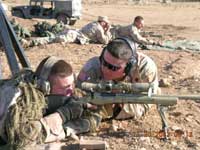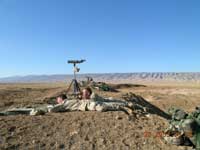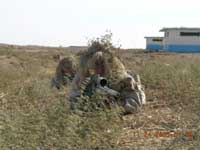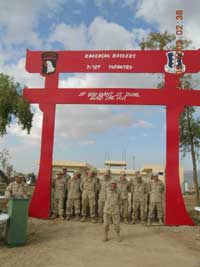 |
| An Instructor of the National Guard Marksmanship Training Center Sniper Course, instructs a member of the 101st Airborne Division on some of the finer points of combat sniper techniques in Northwest Iraq. This was the first time since 1968 that a sniper training school was held on foreign soil. |
For the first time since 1968, a sniper school was held on foreign soil during combat. The National Guard Marksmanship Training Center sent the cadre of its sniper course instructors to northern Iraq to train the soldiers of the 101st Airborne Division (Air Assault) in skills that have
proven to be useful during combat operations.
Soldiers from the division’s three infantry brigades discussed the need for sniper training. The request for the course went up the division chain of command until it was put to the soldiers who work at the training center.
“All this stuff starts off as a great idea by a private first class or a specialist, then makes its way up the ranks,” said CSM Marvin Hill, division command sergeant major. “The 101st ran jump school in England, so why not the Air Assault school in Iraq? Why not the sniper school?”
 |
| Members of the 101st Airborne Division undergoing sniper school in Northwest Iraq assist each other in training. The open landscape of Northwest Iraq made it ideal for the sniper school, with space for long-distance firing up to 800 meters. |
The sniper course normally runs at Camp Robinson, North Little Rock, Arkansas. The version ran in Iraq was changed to suit the environment, said SFC Bret Boatright, noncommissioned officer in charge of the sniper course. “According to training and doctrine we can adjust the program of instruction by twenty percent, so we have a little flexibility there,” Boatright said.
Instead of the usual five-week course, the course was compressed to three weeks. To do this, the instructors had to cut out days off and add hours of teaching time to the remaining workdays. In the end, the soldiers spent the same number of hours learning sniper skills as students do in the original course taught at Camp Robinson. “They still ran the 398 hours,” stated SSG Dominic Barnello, sniper course cadre member. “It’s not condensed, it’s compressed together, they got it all at once. It’s a little harder on them because there’s a lot of information flushed into their brains at once.”
 |
| Members of the 101st Division demonstrate the camouflage and fieldcraft techniques they learned from the National Guard Marskmanship Training Center Sniper Course that traveled to Iraq in November of 2003. |
The sniper school was set up in Northwest Iraq because of its vast prairies. The openness of the landscape lent itself well to the long firing ranged that had to be built to accommodate the weapons training in the course, said CSM Rory Malloy, 2nd Battalion, 187th Infantry Regiment, 101st Airborne Division (Air Assault). According to CSM Malloy, the 101st soldiers appreciated being taught the techniques and skills that can be applied to their current situation in Iraq. “The cadre brought to the table a lot of great skill, they’ve been a great asset,” Malloy said. “The guys out here are real motivated to do this.”
It’s not just deployed soldiers who are enjoying the learning opportunities, cadre members were glad to be teaching soldiers taking part in Operation Iraqi Freedom. “As soon as I found out that we were going, I was ecstatic. What’s better than to bringing the training to them?” Barnello said.
 |
| The graduating class of the first sniper course held on foreign soil since 1968. These members of the 101st Airborne Division underwent five weeks of training in three weeks. They will go on to share the skills they learned with other members of their division. Hats off to these and all of the fighting men and women of the United States Armed Forces! |
The students relished the chance to learn combat skills that make them a bigger asset to their units. “It was a good opportunity to perfect marksmanship skills and learn all the techniques,” said SPC Bryce Baker, scout, 2nd Battalion, 187th Infantry Regiment. “There was a lot of information thrown at us real quick, but they’re good teachers and we’re here to learn.” Like the other 19 students, Baker plans on taking his newly acquired skills back to his unit where he’ll be able to pass his knowledge on to others and make the unit stronger.
The sniper course is divided into two portions. In the first part, the students undergo marksmanship training. Using their M-24 Sniper Weapon Systems, they learn how to hit targets at distances ranging from 100 to 800 meters. The budding snipers learn to stationary and moving targets during the day and night. They also learn how to judge and adjust for unknown distances. During the second phase they learn sniper fieldcraft. This includes range estimation, creating camouflaged and concealed clothes and environments, and detecting unnatural movements or objects. They also learn stalking, where they have to move within a certain distance of a target and fire without being detected. The course instructors ran the class only once, then returned to America. In the spring, the instructors will return to Iraq and stay for six months. |



